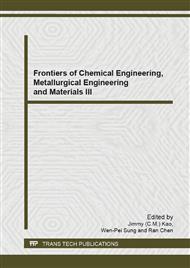p.341
p.346
p.350
p.356
p.359
p.363
p.368
p.371
p.375
Sol-Gel Synthesis and Characterization of Nanocrystalline Bi4Ti3O12 Powders
Abstract:
Nanocrystalline bismuth titanate (Bi4Ti3O12; BTO) powders were successfully prepared by the sol-gel method, using bismuth nitrate (Bi(NO3)3·5H2O) and tetrabutyl titanate (Ti(OC4H9)4) as source materials, acetic anhydride and ethanediol as solvents. The thermal decomposition and phase inversion process of the gel precursors were studied by using differential thermal analysis (DTA). The crystal structures and microstructures of BTO powders were investigated by using x-ray diffraction (XRD), and transmission electron microscope (TEM). The crystallization of amorphous bismuth titanate has been discussed. The effect of sintering temperature on the structure and morphology of BTO was investigated. At 644 oC and above, BTO powder undergoes a phase transformation from tetragonal to orthorhombic. At 900 oC, the purified orthorhombic BTO nanocrystals were obtained.
Info:
Periodical:
Pages:
359-362
Citation:
Online since:
August 2014
Authors:
Keywords:
Price:
Сopyright:
© 2014 Trans Tech Publications Ltd. All Rights Reserved
Share:
Citation:


